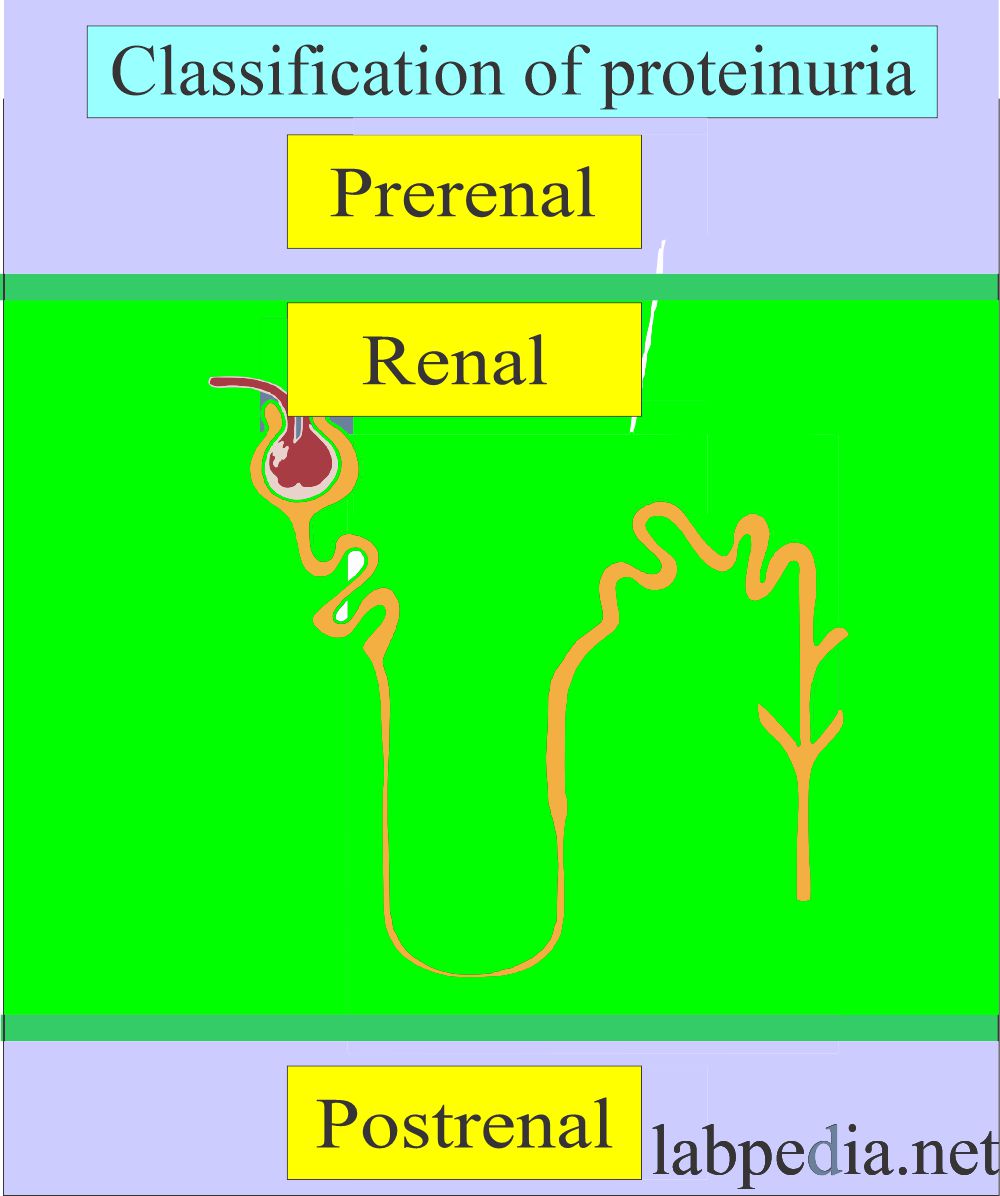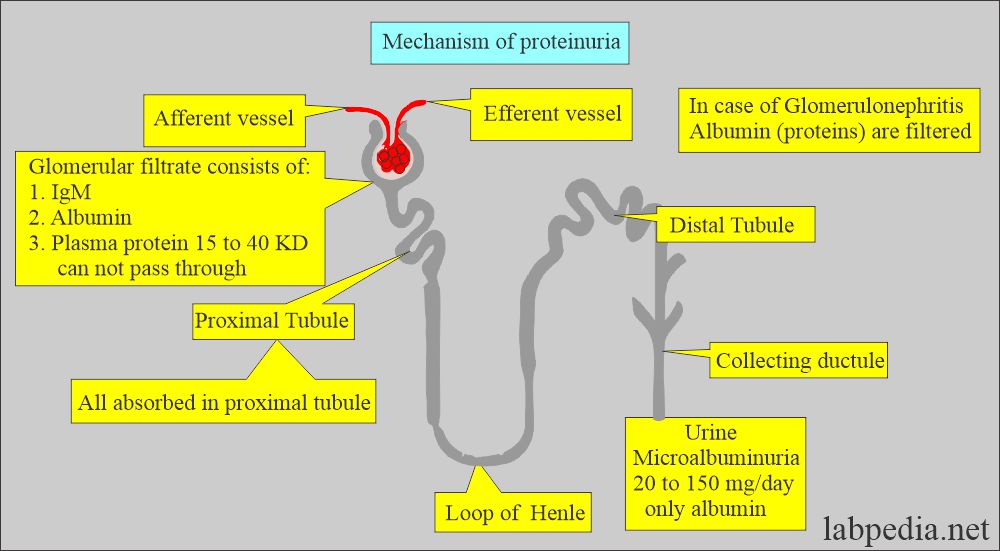Urine protein 24-hour, Classification of Proteinuria
Urine protein (24-hour)
How will you collect samples for urine protein in 24 hours?
- Collect a random sample of urine to rule out the presence of protein.
- 24-hour urine is collected in a sterile container.
- Discard the first sample, note the time, and then collect all other samples for 24 hours.
- The last time a urine sample is collected in the container.
- While collecting the urine, keep the sample in the refrigerator.
- Add a few ml of HCL into the container.
- Even if you do not add preservatives, there is no issue; only refrigeration is needed.
- Centrifuge and adjust to pH 7.0.
- Analyze a fresh sample.
What are the precautions for Urine protein 24-hour?
- Avoid dehydration due to the lack of fluid intake.
- Avoid the contamination of urine from the vaginal secretions.
- Not adequate collection during urinary tract infections (UTI).
- Avoid using contrast media in radiology within the last three days.
- Avoid strenuous exercise.
- Avoid emotional stress.
- Avoid feces contamination.
- If needed, clean the urethral area.
- In heavy menses and discharge, postpone the test.
- The ladies can use a wide-mouth container and transfer the urine into the bottle.
- Ideally, refrigerate the container or keep it on ice.
What are the indications for Urine protein 24-hour?
- The presence of protein in urine is an indicator of renal diseases.
- This may be done to evaluate the edema.
- It is advised in diabetic patients.
- It is advised in hypertensive patients to see the kidney damagae.
- Advised to see the chronic kidney disease progress.
- Proteinuria is a marker of increased risk for cardiovascular disease.
- It is advised in autoimmune diseases.
How would you discuss the pathophysiology of Urine protein?
- The amount of substances excreted in 24 hours in urine by the kidneys is variable, so a random sample will not give the exact result.
- So, for the protein, electrolytes, and creatinine, a 24-hour urine sample is the answer.
- Proteins are found in:
- Blood.
- Urine.
- CSF.
- Amniotic fluid.
- Saliva.
- Feces.
- In a healthy individual with normal renal function, proteins will not be present in the urine, or only traces may be found.
- Urine protein sources are:
- From the blood.
- From kidneys.
- From the urinary tract.
- From the vagina and prostate.
How will you classify proteinuria based on the amount of protein excreted in the urine?
| Proteinuria based on the amount | Amount of the protein |
Etiology |
|
|
It may be due to:
|
|
|
It may be seen in the following:
|
|
|
It is seen in the following:
|
What are the types of proteinuria?
- Proteinuria may be:
- Transient proteinuria:
- It may be seen temporarily, like in exercise, fever, dehydration, and stress.
- Pathological proteinuria:
- It indicates kidney disease or systemic disease.
- It may be seen in diabetes, hypertension, glomerulonephritis, and kidney diseases.
- Tubular damage proteinuria:
- Renal tubules fail to reabsorb protein like tubulointerstitial nephritis.
- Orthostatic proteinuria:
- This proteinuria appears when standing and disappears when lying down.
- Overflow proteinuria:
- Excess protein appears in the urine, as in the case of multiple myeloma.
- Transient proteinuria:
What is the mechanism of protein in the urine?
- Urine is formed by the ultrafiltration of plasma across the glomeruli.
- Plasma protein with molecular weight >40,000 is retained in the plasma.
- Normally, the glomerular membrane does not allow protein filtration into the urine because of narrow spaces in the glomerular membrane.
- In glomerulonephritis, the glomerular membrane is injured, and there are larger spaces from where the protein, particularly albumin (smaller in size), can easily pass in the urine.
- Albumin is 1/3 of the urinary protein.
- Albumin is filtered through the glomeruli very easily compared to plasma globulin.
- In pathologic conditions, Albumin is abundant.
- Urine Albumin is used as the protein marker of glomerular permeability.
- The term proteinuria is often used synonymously with Albuminuria.
- Protein is the single most important parameter for renal dysfunction.
- If more than a trace of protein is found in urine, advise 24-hour urinary protein.
- Mechanisms will include:
- Kidney diseases.
- Systemic diseases.
What is normal urine protein 24 hours?
Source 1
- 1 to 14 mg/dL
- At rest = 50 to 80 mg/day
- After intense exercise = <250 mg/day
another source
- The normal albumin excretion rate is <20 µg/minute.
- Or <30 mg/day
- Adult male = 10 to 140 mg /L OR = 1 to 14 mg/dL
- Adult female = 30 to 100 mg/L OR 3 to 10 mg/dL
- Child <10 years = 10 to 100 mg/L OR 1 to 10 mg/dL.
- < 150 mg/24 hours.
- Qualitative = normally negative.
- Significant proteinuria is > 300 mg / 24 hours.
How will you diagnose urine protein 24-hour?
- A 24-hour urine sample is needed.
- Urine protein assays are sensitive to all types of proteins like albumin, globulins, and Bence-Jones protein.
- Most assays can detect a minimum of 3 mg/dL of protein in the urine.
- Urine dipstick is most commonly used. This is most sensitive to albumin.
- The dipstick can detect albumin when it is about 18 mg/dL
What are the causes of increased proteinuria?
- Glomerular diseases :
- Acute and chronic glomerulonephritis.
- Nephrotic syndrome.
- Polycystic kidney
- Amyloidosis.
- Autoimmune diseases like SLE.
- Diabetes mellitus.
- Malignant hypertension.
- Decreased tubular reabsorption :
- Acute and chronic pyelonephritis.
- Renal tubular diseases.
- Wilson’s disease.
- Fanconi’s syndrome.
- Interstitial nephritis.
- Cystinosis.
- Other causes are :
- Congestive heart failure.
- Multiple Myeloma.
- Malignant Lymphoma.
- Waldenstrom’s macroglobulinemia.
- Trauma and stress.
- Acute infections like septicemia.
- Toxemia of pregnancy.
- Hyperthyroidism.
- Poisoning from phosphorus, gold, mercury, lead, and phenol.
- Drugs like opiates, etc.
- Hypertension.
- Postural proteinuria.
Questions and answers:
Question 1: What is the limit of the dipstick to detect proteinuria?
Question 2: Where does protein absorb in the glomerulus?





V informative
Thanks.